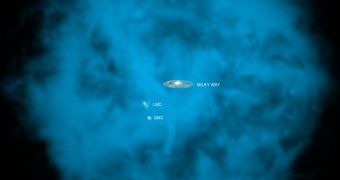In a new study that could easily solve the missing baryon problem for the entire Milky Way, researchers have found that our galaxy is in fact embedded in a very large cloud of hot gas, which extends for hundreds of thousands of light-years in all directions.
To get a sense of scale, the galaxy itself is only around 120,000 light-years across. Astronomers now believe that the enormous halo of hot gas surrounding it contains about the same amount of mass as all the stars and stellar clusters within.
The new study was conducted using the NASA Chandra X-ray Observatory, which is capable of surveying the high-energy Universe at high-resolution levels. The proposed size and mass of this gas halo still need additional confirmation, but this could easily turn into a monumental discovery.
For starters, it could solve one of the most important mysteries in astronomy today, more precisely the location of around half of the baryons that should exist in the galaxy. These baryons are basic particles, including protons and neutrons, which account for more than 99.9 percent of atoms' masses.
When the Universe was just a couple of billion years old, baryonic matter accounted for 16.6 percent of all dark matter in the Cosmos. Now, more than 10 billion years later, 50 percent of the baryonic matter that existed in the past is unaccounted for.
Using data from Chandra, the European Space Agency's (ESA) XMM-Newton space telescope, and the Japan Aerospace Exploration Agency (JAXA) Suzaku satellite, a team of five astronomers was able to learn more about the temperature, size and mass of the hot gas halo surrounding the Milky Way.
“We know the gas is around the galaxy, and we know how hot it is. The big question is, how large is the halo, and how massive is it?” explains investigator Anjali Gupta, who was the lead author of a new paper detailing the study. The work appears in the latest issue of the esteemed Astrophysical Journal.
One of the most significant findings made in the new study is that the halo appears to contain enough material to outweigh 10 billion suns. In fact, the total amount of mass in the halo could very well exceed 60 billion solar masses, although the measurements still need some refining.
“Our work shows that, for reasonable values of parameters and with reasonable assumptions, the Chandra observations imply a huge reservoir of hot gas around the Milky Way,” Ohio State University expert and study coauthor, Smita Mathur, explains.
“It may extend for a few hundred thousand light-years around the Milky Way or it may extend farther into the surrounding local group of galaxies. Either way, its mass appears to be very large,” she concludes.

 14 DAY TRIAL //
14 DAY TRIAL //